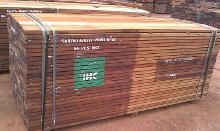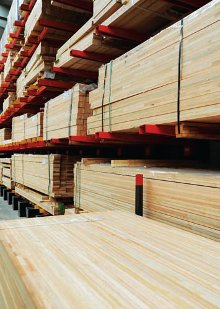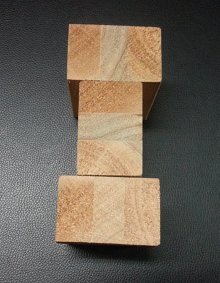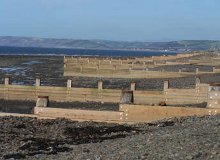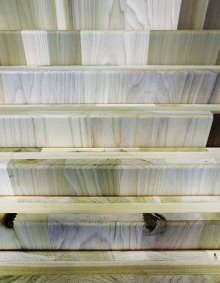Hardwood sector moves to a better place
5 October 2013The consensus is that the hardwood market is turning around and traders are happier with business levels. Mike Jeffree reports
If we could get more wood, we could sell it."
This importer's comment summed up the hardwood sector's current concerns. In contrast with earlier in the year, the preoccupation seems more now with tracking down enough timber to meet demand and dealing with firming prices, rather than finding enough customers.
Some still say it's still moving at super tanker pace, but the consensus is that a market turnaround is taking shape. This is borne out by Timber Trade Federation (TTF) statistics. They still show hardwood imports down on 2012, but with the deficit shrinking; -19% January to February, and -13.8% January to June.
"The first three months were terrible due to the weather, economic jitters, and uncertainty about the EU Timber Regulation (EUTR) - which caused the hardwood trade especially to take pause before its introduction in March," said an international trader. "The next three months were patchy, but we've picked up from there and there's more underlying confidence." Another importer/distributor detected a better mood across the business.
"We're up 5% against budget on turnover to the end of August and, while margins have been squeezed, we're still ahead and main customers, importers and merchants, are generally positive," said the spokesperson.
It's too early for the tentative housing building recovery to be benefiting hardwood directly, but the ripples are being detected in other markets.
"The first beneficiaries of construction upturn are structural and first fix products, so softwood and panels," said an importer/distributor. "But this early improvement may be leading to more confidence in property generally, so people are going ahead with delayed improvement projects; fitting kitchens, perhaps some flooring and joinery."
"We're ahead on lumber generally, except in African, and that's down to supply," said an importer. "Flooring is OK and there's stronger joinery demand, including for hardwood worktops, despite stiffer competition from cheaper granite and composites."
An agent/distributor said that the summer weather had pushed hardwood decking "up dramatically".
"A number of our importer [customers] have also seen steady growth from joinery manufacturers," said the spokesperson. "Across the board there have been fewer bad debts and companies going bust."
Signs of a pick-up in commercial construction and interiors are also reported.
"We're selling good volumes of paint grades to door customers for office developments and also higher end hardwoods, particularly to joinery customers in the south-east working on banks and hotels," he said.
The trade seems as much in one mind on growing supply side issues, as on the gradually improving market mood.
Sapele shortages
The key topic of conversation here is Africa, and more specifically sapele, which has been hit by several supply factors at once. First, many mills have still not returned to pre-slump capacity. Competing demand also continues to build elsewhere, notably the BRIC economies, but also now in the recovering US. There are also reports of lower timber volumes coming out of the forests. Latest civil disruption in the Central African Republic is cited as one cause, but others seem less understood.
"We've found less sapele in new concessions we're working - 50% of off-take against 80-90% in previous areas," said an importer/supplier. "It might be a natural blip, but we're hearing similar reports from other concessions. It's not clear why."
The consequence of all this, plus continued relative weakness of sterling against the euro, is that sapele prices are quoted 15-25% up on the year and mills are committed until March/April.
"And prices could rise 5-10% more this year," said an importer.
Other African species are not yet under such pressure, with both iroko and framire reported relatively steady in recent months. However, one importer thought that "capacity constraints" and market upturn, particularly US demand, may result in firming here too.
In a sector which one distributor described as "littered with inconsistencies as we emerge from recession", Far Eastern prices have been "stable to weak", with dark red meranti easing against rising freight levels and balau decking falling.
"This could be down to producers not shedding capacity like African mills in the slump, combined with their Asian markets starting to cool," he said. "China is clearly slowing and Thailand, Indonesia and Malaysia have issued lower growth estimates."
Keeping an eye on EUTR
Another factor tropical hardwood traders in particular have been keeping a weather eye on is the ongoing effect of the EUTR. So far, however, the jury seems out on the fallout.
"Some attributed sharper drops in tropical against other hardwood imports earlier this year to the EUTR deterring buyers from what they saw as higher illegal risk sources, but in today's improving market the differential seems less," said an importer. "It's hard to separate Regulation impacts from other factors."
An agent/distributor also said there was further evidence that the flight from Ivory Coast framire - expected to struggle to meet EUTR due diligence legality requirements - hasn't materialised.
"Some importers dropped it, waiting to see what happened, but we've approved two main suppliers as satisfying due diligence and are seeing increased demand."
Another concern was that the introduction of the EUTR might result in a fall-off in demand for certified sustainable hardwood, with customers opting for legality verification alone. But while one importer reported first requests for "EUTR-compliant" timber, there are no widespread signs of a drift from certification.
"It may change as the EUTR becomes more embedded, and it will be interesting to see the effect of the first shipments of Indonesian timber verified legal under its EU FLEGT Voluntary Partnership Agreement (p10)," he said. "But customers who specify certified, notably the big corporates and government buyers and contractors, have FSC or PEFC locked into procurement strategies."
Overall, said an importer/distributor, the hardwood trade seems to be "integrating EUTR into day-to-day business". "It may cause more anxiety if we see UK prosecutions but, while it's added bureaucracy, it's not a big departure," he said. "I can't speak for manufacturers and others who import direct, especially an ad hoc, but bona fide traders had due diligence in place already. So it's been more a case of aligning this to the Regulation."
The EUTR was never expected to be an issue for low illegality risk US hardwoods, and so it has proved. Importers do report supply and price challenges, however.
"US economic recovery is underpinning prices across species," said another importer. "White oak and walnut are strong and poplar/tulipwood didn't dip as usual this summer. While it still doesn't sell much here, red oak has also moved up on the back of US domestic joinery growth and ash has remained firm, partly due to demand, partly to emerald ash borer infestation, which limits availability."
European prices have been less of a hot topic, with the main seller, oak remaining "unexciting" and even some downward pressure reported due an increased presence of D-grade. The exception, cited by several importers, however, has been colour no-defect beech, which has been heading upward.
Some see the latter as the result of an increase in demand thanks to customers looking for a cheaper alternative to sapele. However, the consensus is that, so far, the market is absorbing price rises for the latter, and its other traditional favourites, notably US white oak.
"How long we can keep asking for more remains to be seen," said an importer. "But currently we're not meeting huge resistance. Basically the UK remains a conservative hardwood market and it takes a lot to price it into a new direction."
New species and products
As reported in TTJ's tropical market focus, traders are bringing new species and products to market. The rationale ranges from broadening customer choice, to taking up the growing selection of value-added products offered by suppliers and widening the pool of legally verified and certified material in response to the introduction of the EUTR.
And traders do report increasing interest in species such as movingui and guariuba and, most notably, plantation eucalyptus grandis, and also for laminated, finger-jointed sapele and oak scantlings and other engineered products. Generally, however, it is felt that the UK's inherent hardwood conservatism will make most of them slow burn.
"And it's not just a question of people being stuck in their ways," said an importer. "It is quite a big deal for end users to re-gear to the characteristics of alternative species and for specifiers to persuade their customers."
But while the market is not without continuing issues and challenges, the recurring theme among traders is that, regardless, it is in gradually improving health.
"The key budget topic is increasingly where we're going to get the timber and at what price, rather than where we'll sell it," said an importer. An importer/distributor also said they were "happy with where business is".
"What we need now is two to three months of steady business and I think trade optimism will really start to grow," he said.
Another "remained positive".
"We expect September to November to be on budget and we've placed a number of back-to-back orders for 2014, which is encouraging."
Marine hardwoods sink - but outlook improving
This year has seen a downturn in the marine hardwood sector of 30-40% according to one leading supplier - but the outlook is now brighter.
"Marine projects, such as coastal defences and inland waterway works, are a long time in planning, so the downturn we saw this year was a hangover from the recession," said an importer/supplier. "We have also seen local authorities, in particular, going for tropical hardwood alternatives, such as Douglas fir This isn't anything like as durable as, say greenheart, which has been particularly hit, but on a £2.5m job might save them £200-300,000 and they're looking to save now."
On a brighter note, the company had seen strong sales to the railway network and increased interest in some lesser-known heavy-duty species, such as eveuss and okan.
"And order books are now picking up for marine work," said the spokesperson. "I think we're through the worst."
